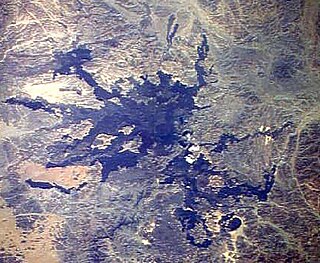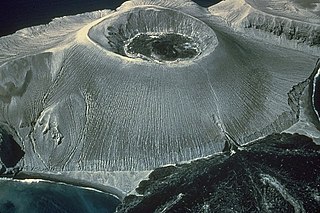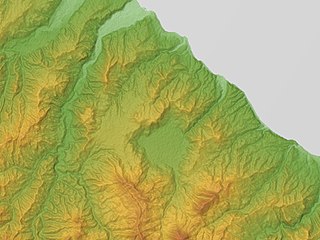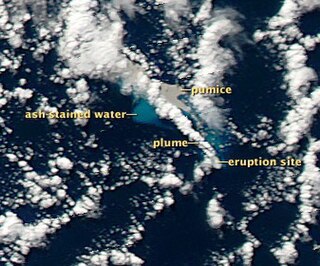Related Research Articles

A seamount is a large submarine landform that rises from the ocean floor without reaching the water surface, and thus is not an island, islet, or cliff-rock. Seamounts are typically formed from extinct volcanoes that rise abruptly and are usually found rising from the seafloor to 1,000–4,000 m (3,300–13,100 ft) in height. They are defined by oceanographers as independent features that rise to at least 1,000 m (3,281 ft) above the seafloor, characteristically of conical form. The peaks are often found hundreds to thousands of meters below the surface, and are therefore considered to be within the deep sea. During their evolution over geologic time, the largest seamounts may reach the sea surface where wave action erodes the summit to form a flat surface. After they have subsided and sunk below the sea surface such flat-top seamounts are called "guyots" or "tablemounts".

Lava lakes are large volumes of molten lava, usually basaltic, contained in a volcanic vent, crater, or broad depression. The term is used to describe both lava lakes that are wholly or partly molten and those that are solidified.

MenengaiCrater is a massive shield volcano with one of the biggest calderas in the world, in the Great Rift Valley, Kenya. It is the largest volcano caldera in Kenya and the second largest volcano caldera in Africa. Volcanic formed rich loam soils enrich the adjacent farmland arounds its flanks. The crater is on the floor of the Rift Valley. The volcano formed about 200,000 years ago and the prominent 12 x 8 km caldera formed about 8000 years ago. The caldera floor is covered with numerous post caldera lava flows. The Menengai volcano is considered one of the best-preserved Krakatau-style calderas in the world. Menengai has very little sediment in the caldera which is a thick mass of lava boulders and inaccessible ridges. Volcanic activity continues and a current project under the GDC is at an advanced stage towards geothermal power generation.

In volcanology, a pyroclastic shield or ignimbrite shield is an uncommon type of shield volcano. Unlike most shield volcanoes, pyroclastic shields are formed mostly of pyroclastic and highly explosive eruptions rather than relatively fluid basaltic lava issuing from vents or fissures on the surface of the volcano. They typically display low-angle flank slopes and often have a central caldera caused by large eruptions. Lava is commonly extruded after explosive activity has ended. The paucity of associated Plinian fall deposits indicates that pyroclastic shields are characterized by low Plinian columns.
The Boomerang Seamount is an active submarine volcano, located 18 km northeast of Amsterdam Island, France. It was formed by the St. Paul hotspot and has a 2 km wide caldera that is 200 m deep. Hydrothermal activity occurs within the caldera.

Fonuafo‘ou, formerly known as Falcon Island, is a submarine volcano in the western part of the Ha'apai group in Tonga. The volcano has created an island several times throughout history.

Yuryaku Seamount is a seamount and guyot (flat-topped) located northwest of Hawaii. It is located a little southwest of the V-shaped bend separating the Emperor Seamounts from the older Hawaiian islands, all of the Hawaiian-Emperor seamount chain in the North Pacific Ocean.

Ḥarrat Lunayyir is a lava field in northwestern Saudi Arabia. In 2009 there were swarms of small earthquakes in the area; 2289 people were evacuated from the area. Fissures opened on the surface, and the area might now be considered volcanically active.

The Bárcena volcano is an active but not currently erupting cinder cone type volcano that encompasses the southern end of the San Benedicto Island, Mexico. It is grouped with a chain of volcanic islands known as the Revillagigedo Islands, Mexico. These islands are situated in close proximity to each other, and can be found in the Pacific ocean. They are also considered to be part of the Trans-Mexican Volcanic Belt. Volcán Bárcena is positioned 220 miles off the south-eastern coast of the Baja California Peninsula. The closest city to Barcena is Cabo San Lucas, Mexico.
Coleman Seamount is a submarine volcano in the western Solomon Islands. The volcano was discovered in 1985 by the Hawaiian "Moana Wave" research vessel.

The geology of the Canary Islands is dominated by volcanic rock. The Canary Islands and some seamounts to the north-east form the Canary Volcanic Province whose volcanic history started about 70 million years ago. The Canary Islands region is still volcanically active. The most recent volcanic eruption on land occurred in 2021 and the most recent underwater eruption was in 2011-12.

Nigorigawa Caldera is a volcanic crater in Oshima, Hokkaido, Japan. It has an elevation of 1,168 ft (356m) and it last erupted 12,000 years ago. The caldera has a diameter of 3km.

Havre Seamount is an active volcanic seamount lying within the Kermadec Islands group of New Zealand, in the south-west Pacific Ocean, on the Tonga-Kermadec Ridge. Its most recent eruption took place in July 2012.
References
- ↑ "Global Volcanism Program | Amsterdam Island | Summary". Volcano.si.edu. Retrieved 2012-07-26.
- ↑ "Amsterdam Island Volcano, South Indian Ocean – John Seach". Volcanolive.com. Retrieved 2012-07-26.
- ↑ Boomerang Seamount: the active expression of the Amsterdam-St. Paul hotspot, Southeast Indian Ridge, K.T.M. Johnson, D.W. Graham, K.H. Rubin, K. Nicolaysen, D.S. Scheirer, D.W. Forsyth, E.T. Baker, L.M. Douglas-Priebe, Earth and Planetary Science Letters 183 (2000) 245–259
- ↑ Rosemary G. Gillespie; D. A. Clague (2009). Encyclopedia of Islands. University of California Press. p. 441. ISBN 978-0-520-25649-1.
- ↑ "Boomerang Seamount, South Indian Ocean – John Seach". Volcanolive.com. Retrieved 2012-07-26.
- Siebert L, Simkin T (2002–present). Volcanoes of the World: an Illustrated Catalog of Holocene Volcanoes and their Eruptions. Smithsonian Institution, Global Volcanism Program Digital Information Series, GVP-3 (http://www.volcano.si.edu).